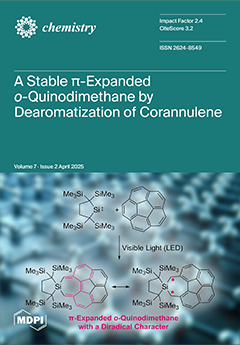A novel series of oleanolic acid (
OA,
1) derivatives incorporating phenolic and coumarin moieties were synthesized. This acid was extracted from olive pomace (
Olea europaea L.) using an ultrasound-assisted method. The structures of these novel derivatives of
OA were
[...] Read more.
A novel series of oleanolic acid (
OA,
1) derivatives incorporating phenolic and coumarin moieties were synthesized. This acid was extracted from olive pomace (
Olea europaea L.) using an ultrasound-assisted method. The structures of these novel derivatives of
OA were characterized through the utilization of
1H-NMR,
13C-NMR and ESI-HRMS analyses. An evaluation of some biological activities of the prepared derivatives was conducted. The evaluation focused principally on the capacity of these structures to inhibit 15-lipoxygenase and
α-glucosidase, as well as their anticancer properties when tested against tumour cell lines (HCT-116 and LS-174T) and a non-tumour cell line (HEK-293). In terms of their cytotoxic activity, the majority of the compounds exhibited notable inhibitory effects compared to the starting molecule,
OA. Derivatives
4d,
4k and
4m exhibited particularly strong inhibitory effects against the HCT-116 cell line, with IC₅₀ values of 38.5, 39.3, 40.0 µM, respectively. Derivatives
4l,
4e and
5d demonstrated the most effective inhibition against the LS-174T cell line, with IC
50 values of 44.0, 44.3, 38.0 µM, respectively. However, compound
2a was the most effective, exhibiting the most potent inhibition of 15-lipoxygenase and
α-glucosidase, with IC₅₀ values of 52.4 and 59.5 µM, respectively. Furthermore, molecular docking studies supported in vitro cytotoxic activity, revealing that the most potent compounds exhibited low binding energies and interacted effectively within the EGFR enzyme’s active pocket (PDB: 1M17). These findings highlight the potential of these derivatives as anticancer agents and enzymatic inhibitors, warranting further investigation.
Full article





